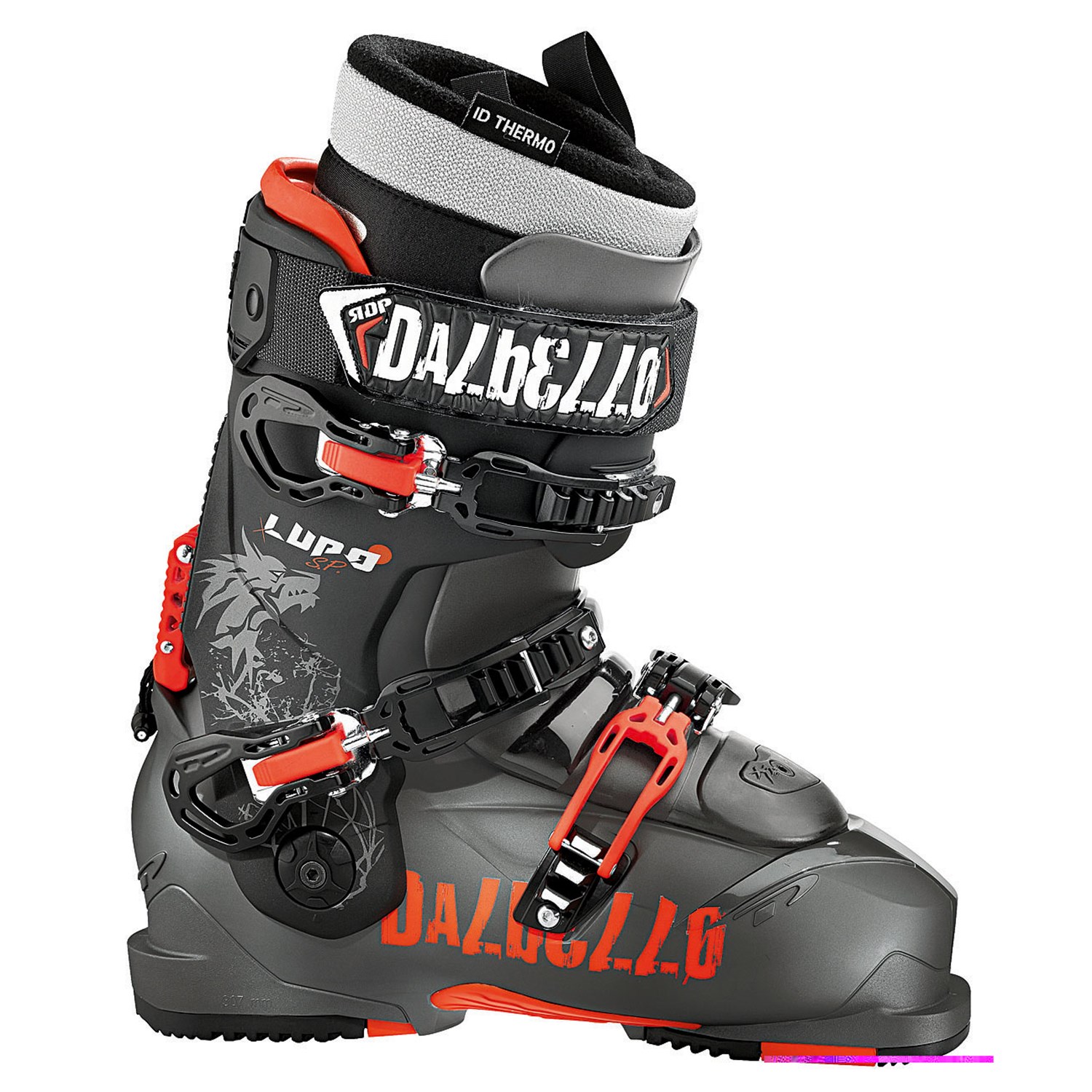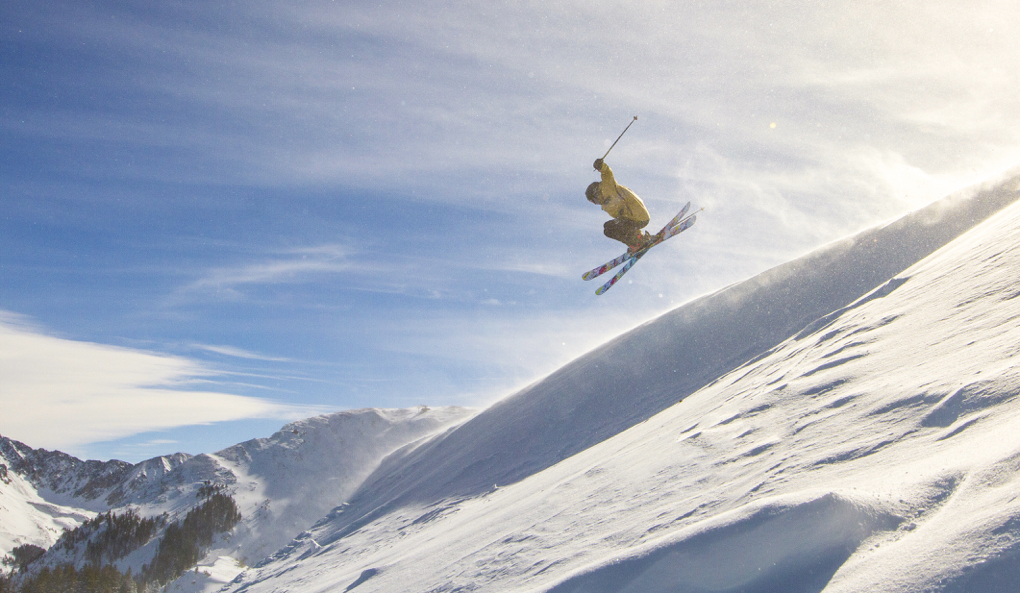
2015-2016 Dalbello Lupo SP I.D.
Stated Flex: 110 for C “Medium” tongue and 130 for B “Stiff” tongue
Stated Last Width: 98mm
Size Tested: 24.5
Features:
- Ski/Hike switch
- 3 Piece Cabrio Design
- 2 switchable tongues included
- Intuition I.D. KR Max Liner
- High traction rubber toe & heel blocks
- High density rubber center arch
- Twin Canting Adjustment
MSRP:$700
Reviewer Info:
5’ 10”, 135 lbs.
Feet: A width, medium volume, high arch & instep
Days Tested: 7
Locations tested: Taos Ski Valley; Rotwald, Weirihorn, Switzerland
I have a narrow foot with a comparatively huge instep, and 3-piece boots have always fit me well. I’ve been skiing various 3-piece Dalbello Krypton models or the past 8 years, mostly the Il Moro, and I’ve generally been quite happy with them.
But when Dalbello released the Lupo SP, I knew I had to try it out. As essentially a more freestyle-oriented KR2 Pro with a walk mode, the Lupo seemed like it could be the ideal freeride boot for skiing and hiking around the resort. And after a number of days in the boot, I can say that, for me at least, it’s indeed pretty close to perfect for in-bounds freeriding.

Fit & Liner
Seeing a good boot fitter is the best way to figure out what boots fit you best, but I’ll give my $0.02 on the fit of the Lupo.
As I mentioned above, I have a very narrow foot with a very high instep, and given that, the Lupo’s 3-piece shell provides a great fit. At times I wished the boot’s last was 1-2mm narrower for my foot, but I doubt most people with average-width feet will feel that way.
Even though the boot is a tiny bit wide for me through the midfoot, most importantly, the Lupo has an excellent heel pocket and offers great heel retention. I haven’t experienced any noticeable heel lift in the boot (my shell fit leaves 1-1.5cm of space behind my heel), and part of this seems to be due to the Lupo’s Intuition Power Wrap liner.
Personally I’d much rather ski a boot with a Power Wrap liner over Intuition’s standard tongue liners (or any stock tongue liner, for that matter). I find the that Power Wrap’s wrap-around design offers superior power transmission, comfort, and warmth. The liners are also typically a bit stiffer than a stock liner and, as I’ll say more about below, contribute to the Lupo’s overall flex, which seems on the stiff side relative to other boots with the same flex rating.
One note on the fitting process with a pair of Intuition Power Wraps (in the Lupo, or any other boot): in my experience, after you’ve had them heat molded, the liners will still have a break-in period of a couple days, and it can be a pretty uncomfortable process. Intuition liners don’t pack out as much or as quickly as a stock liner. I wore a pair of paper thin ski socks during the molding process in order to yield the tightest fit possible with the Power Wraps in the Lupo. Ultimately it all paid off, but I had some issues with numb toes and a horrendous case of the screaming barfies (google it if you don’t know) in the first few days I wore the boots.
Features
The Lupo SP I.D. is essentially the KR2 Pro I.D. with a hike/walk mode, replaceable rubber toe and heel blocks, and a rubber arc tread. The Lupo has the same 98mm last, an Intuition Power Wrap liner, and also comes with two interchangeable tongues to adjust the flex of the boot.
Heel & Toe Lugs
The Lupo’s replaceable heel and toe lugs (made of pretty hard rubber) are a huge bonus if you do a lot of scrambling, walking around, or hiking in your boots. Some people seem to think rubber lugs reduce the precision of a boot, and I’m sure there is a small amount of movement that goes on between the sole and the binding, but I haven’t noticed any reduced of performance in the Lupo in this respect. If anything, the Lupo seems significantly more precise than my last pair of 2010 Il Moros. I skied my Il Moros clicked into a Look Race 12ti alpine binding with a the soft boot board, though, while the Lupos have a stiff boot board, and I have been skiing them in a Marker Baron.
Hike/Walk Mode
The most notable feature on the Lupo is, of course, the hike/walk mode.
I’ll admit, I was initially worried that the hike/ski function would compromise the power and precision of the Lupo on the down, but the latch mechanism itself is super burly. A big aluminum block hinges off of the back of the boot’s upper cuff of the boot, and when locked in ski-mode, hits an equally burly ridge of plastic at the back of the lower shell, keeping the cuff from flexing back at all. (I’ll say more about the Lupo’s downhill performance below.)
When the ski/hike latch is pulled up, the cuff is free to hinge back farther, allowing for more articulation and a more natural walking motion in the boot. The range of motion gained with the Lupo’s walk mode isn’t close to that of a more dedicated touring boot, though, so for a long backcountry tour, I’d much rather be in a more touring-focused boot like the Scarpa Maestrale.
(Dalbello is actually releasing a more touring-oriented version of the Lupo boot for the 2015-2016 season, the Lupo T.I., which we’re quite curious about. It features a lighter construction and tech fittings for use with touring bindings, but it is said to offer the same downhill performance of the Lupo SP.)
The Lupo’s walk mode is nice to use when you’re tromping around building a kicker, hiking a boot pack in the resort, or going for a short side country skin. It’s a good feature to have, but it does come with a few tradeoffs:
- The walk mode eliminates the ability to adjust the Lupo’s forward lean, and that could be a deal breaker for many folks, as I’ll explain below.
- The aluminum block is secured with a small spring. The spring wouldn’t be hard to replace, but if it broke at the top of a sketchy line, you’d be skiing in walk mode.
- There is a plastic toggle on a piece of webbing that you pull to engage the walk mode. I can hear this piece of plastic bouncing off my boots when I ski, and it is pretty annoying.
NEXT: Flex & Downhill Performance

How does the Lupo instep compare to the cavernous instep on the Cochise 120? I have Fred Flintstone feet, and the Cochise with no insole fits my instep almost perfectly.
Hey Blister, any chance you can add to this review with reviews of Lupo TI models?
How does the forward lean of the Lupo compare to the Salomon X Pro 120? I’ve been skiing the XPro, but want something that fits a bit snugger, has a hike/walk mode, but skis similarly as far as stance is concerned. I can’t find detailed information about the forward lean of the XPro … with 9 degrees of forward lean, is it a significant difference?
Thanks,
Matt
Hey Matt,
Although I’ve never skied the X Pro 120, I imagine that it has more forward lean than the Lupo. The Lupo is a really upright boot for driving wider, neutral stance freeride skis while the X Pro seems a bit more traditional. Most boots land in the 12-16deg range while the Lupo at 9deg is a bit of an outlier. That being said, there is a lot that goes into forward lean and the shell geometry is only one of those things. Liners, fit and hinge point also impact forward lean a good bit.
Definitely go into a shop and try on the Lupo though, it might be a good fit for you and you’ll only know by checking it out in person at a good boot fitter.
Thanks for the reply, Sam – I really appreciate it. Try them on is probably the best advice out there. Thanks!
where do i find the c flex tongue? looked everywhere
Hey Ken, both tongues should have come with your boots. If you need a replacement tongue, I would contact Dalbello directly or through a local dealer.
I just received my Lupo SP IDs (2017 model) from evo.com. Only the one tongue came with the boots. Similarly, no additional tongues were advertised to come with the boots from evo. Maybe a change from the previous model years???
Hey Matt, yeah, after some digging it appears that they didn’t include both tongues on last year’s model. I would contact Dalbello directly for different tongues, it’s the best chance of getting replacement parts.
I bought the 2016 lupo so id and the game with a black and orange tongue with no markings, do you know which one is the c?
Hey Ken, on my pair, the black tongues are the “110” flex and the orange tongues are the stiffer “130” flex.
Hi Sam,
Skiing right now in a pair of Dalbello KR2 Core ID 110 but was thinking of getting a pair of Lupo SP ID because of the walking mode. Seems like the forward lean in the KR2 without the wedge is the same as in Lupo (9 degrees) but you have any clue about the flex….love the KR2 110 flex and now a bit worried that the Lupo would be too stiff even with the softer 110 tongue. Any idea if the shell in Lupo is stiffer overall than in the KR2 (as the tongues seem to be the same)?
Thanks,
Tor.
Hey Tor,
I think the 110 flex tongue should be fine for you. As far as I know, the lowers of the KR2 and the Lupo SP ID are the same (except for the walk mechanism). The Lupo with the softer tongue is not an overly stiff boot. It offers a forgiving and progressive flex.
Thanks,
Sam
What’s the successor to these boots? I’m at 140 days in the 15/16 model
I’m in the same boat as Jordan and find myself looking at Roxa now for a carbrio boot… The Lupo series seems to be leaning toward the AX last, and I’d like to keep a walk mode (so I’m not sold on the Krypton).
Hit close to 200 days in the SP ID. Thinking of either giving up the hike mode for a krypton 130 ID this year or the new Lupo Pro HD, with Alpine soles.
Thoughts?